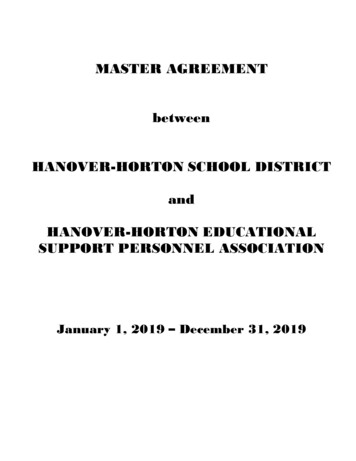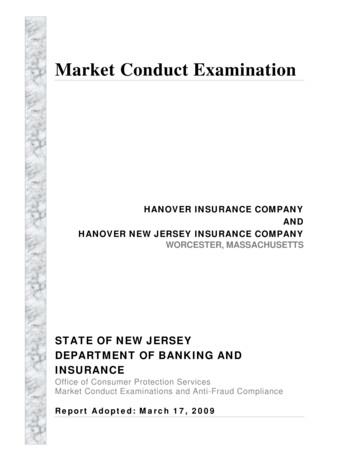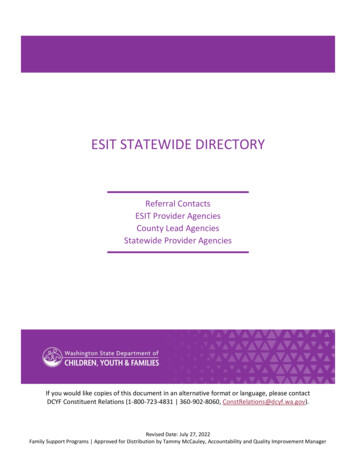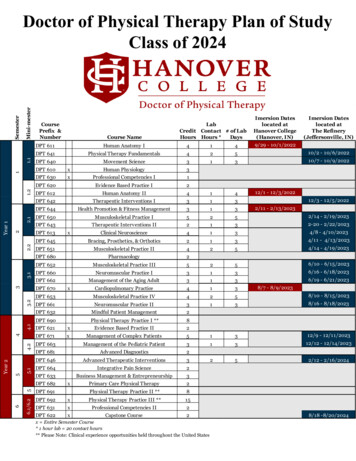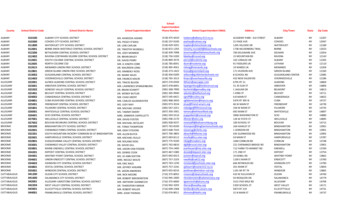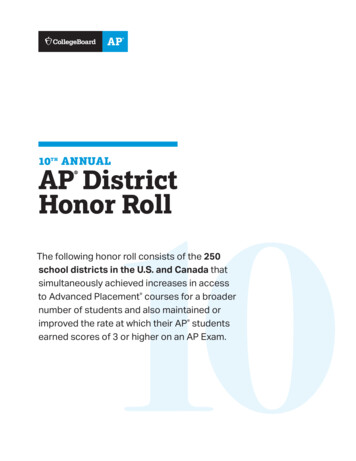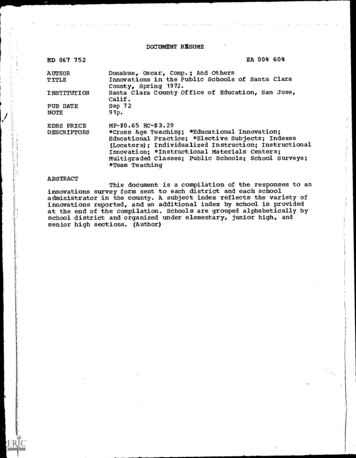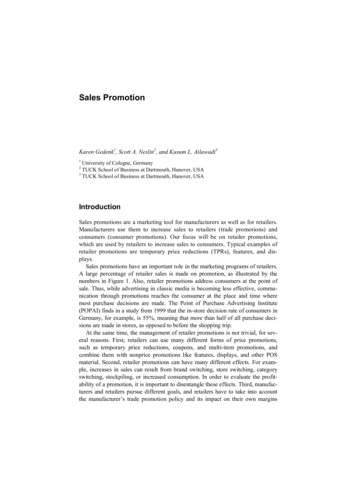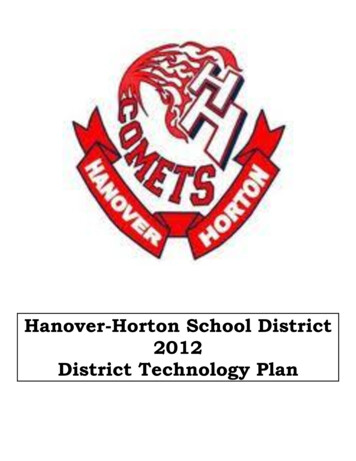
Transcription
Hanover-Horton School District2012District Technology Plan
Table of ContentsPageDescription1Section 1: Identification and Contact Information2Section 2: Introductory Material3Section 3: Mission/Vision and Goals4Section 4: District Needs Assessment5Section 5: Staff Technology Literacy Assessment5Section 6: Professional Development6Section 7: Infrastructure – Hardware and Software7Section 8: Facility Demands7Section 9: Financial Budget and Timetable8Section 10: Increase Access8Section 11: Data Trends10Appendix A15References
Hanover-Horton District Technology PlanSection 1: Identification and Contact InformationDistrict:Hanover-Horton School DistrictAddress:10400 Moscow Rd.Horton, MI 49246District Phone:517-563-0100District Code:38100ISD:Jackson County Intermediate School DistrictPlan Date:July 1, 2012 to June 30, 2013Contact Person:Linda Brian – SuperintendentContact Phone:517-563-0100Contact Fax:517-563-0150Contact Email:linda.brian@hanoverhorton.orgPlan URL:www.hanoverhorton.org1
Hanover-Horton District Technology Plan2Section 2: Introductory MaterialSCHOOL BUILDINGSElementary131 Fairview St.Hanover, Michigan 49241Middle School10000 Moscow Rd.Horton, Michigan 49246High School10000 Moscow Rd.Horton, Michigan 49246DISTRICT PROFILEThe Hanover-Horton School District is a small town atmosphere, yet with the proximity of thedistrict to the I-94 corridor gives the residents of the community easy access to the cultural,educational, and recreational activities in Jackson, Lansing, Battle Creek, Kalamazoo, and AnnArbor.Nearly 1,300 students are served in the district by a staff of 65 teachers. Elementary students ingrades kindergarten through five are located at the elementary school in the village of Hanover.The district’s secondary complex located midway between the villages of Hanover and Hortoncontains grades six through twelve. Construction was completed on a new library at thesecondary complex in January of 2006. District wide all buildings are connected by fiber andnetworked to provide easy access to outside and internal electronic communication. Computerlabs are accessible for all grade levels and curriculum related to the use of technology has beenexpanded. Just recently, the district adopted a virtual school platform. Hanover-Horton VirtualSchool has been in operation for one year and continues to grow in popularity.TECHNOLOGY PLAN INTRODUCTIONHanover-Horton School District’s technology plan first received State of Michigan approval in1995. The original document focused on the development of technical infrastructure, whilesubsequent revisions placed greater emphasis on professional development and the integration oftechnology in the learning experiences of students in the district. During these past seventeenyears All buildings in the district have been connected to each other and the outside world viafiber optic cable, allowing internet access, data sharing, and telephone messagingthroughout the district and to the community. Appropriate filtering software andfirewalls have also been put in place.Individual classrooms in all buildings are wired with fiber optic cable for data,telecommunications, and video.Contracted support staff is in place to manage the system.Six computer labs are installed in the three buildings of the district. One in theelementary complex in Hanover and five in the middle school and high school complex.All computers in classrooms and offices are equipped with Microsoft Office Professional,providing for word processing, spreadsheet, database, and presentation software from anycomputer in the district. While “SDS” administrative software is utilized in the centraloffice, PowerSchool software by Pearson is used in all school buildings. Attendance andgrade reporting are managed electronically and parents have 24/7 access to their child’sgrades through PowerSchool Parent/Student Portal system.An internet website has been developed and maintained at http://www.hanoverhorton.org.
Hanover-Horton District Technology Plan3Increasingly, the use of technology is being integrated into the curriculum and classroom,through the use of word processing, spreadsheet analysis, graphic calculators, electronicpresentation, internet research, or electronic communication.The 2012 revision of the technology plan will focus on the continued support of the technicalsystems that have been put into place and on the further integration of the benefits of technologyinto the classroom and curriculum.Section 3: Mission/Vision and GoalsDISTRICT MISSION STATEMENT: “Creating a better world, one student at a time”DISTRICT TECHNOLOGY VISION STATEMENTIt is the vision of all levels of our school community to provide and maintain a standard oftechnology throughout our school district that will:Enrich the academic curriculum, assist and encourage students in their educationalendeavors.Improve student academic performance through new educational opportunities andservices.Prepare technologically literate graduate who look to technology for knowledge,communication, and career development.Educate students and staff to be ethically aware of their use of information acquired orcommunicated through technology.Provide continuing life learning opportunities to members of our community.Provide efficiency in district operations.Provide a more efficient system/method of assessing our progress in integratingtechnology into the educational structure of the district.Technology will become a natural part of the process, a “tool” by which students in the HanoverHorton School system are educated to become productive citizens, confident in their ownabilities, technically literate, and prepared to succeed.MAJOR GOALS OF THE TECHNOLOGY PLAN1.2.3.4.Improve student learning through the use of technology.Improve staff efficiency in the use of technology.Maintain a technology infrastructure that is appropriate for expected use.Improve interactive technology in every classroom.CONSORTIUM ACKNOWLEDGMENTHanover-Horton School District is part of the School Technology Consortium (STC) withJackson County Intermediate School District (JCISD). The JCISD and Jackson County SchoolDistricts work together to provide internet access, content filtering, online classroom to all theschool districts in Jackson County. They also provide technical services, including network andworkstation management, hardware and software support, helpdesk, and email.
Hanover-Horton District Technology Plan4TECHNOLOGY PLANNING TEAM/STAKEHOLDERSLinda Brian, SuperintendentPam Surque, JCISD System SupportCindy Forgione, Elementary School PrincipalDenise Bergstrom, Middle School PrincipalJohn Denney, High School PrincipalKaren Brockie, Elementary School TeacherTracy Stierle, Elementary School TeacherRhonda Herwat, Middle School TeacherRobin Ellison, High School TeacherDan Draper, High School Assistant PrincipalJoe Childs, School Board Member/ParentTim Yost, ParentMajor Decision #1: Expand the current communication with stakeholders and thecommunity so that more knowledge of the district technology plan is shared. As stated in theState of Michigan Educational Technology Plan (2006), “communication among students, theirparents, and teachers may be strengthened with educational technology, through such means asemail, class information on Web sites, and projects being more engaging and visible to parents”(p. 89). This will allow more ideas to flow through the school for technology needs and involvemore parent support. Based on the current level of communication, the school district could hostmore community forums on technology. This past year the district hosted one forum on socialmedia web sites. Increasing that number to draw more parents would be an excellent start tobring in more involvement. Also, sharing with the stakeholders what the ISTE (2011)technology standards are and what they mean would help in creating a complete buy in for the21st century learner. Offering parents and community members the opportunity to providefeedback via email, surveys, forums, or discussion groups on current technology would also bevery valuable.Section 4: District Needs AssessmentThe Hanover-Horton School District currently does not do an annual formal need assessment.Instead, the technology committee meets semi-annually in October and March to address twoobjectives:1. Assess the stated goals contained in the technology plan. The committee accomplishesthis objective by regularly surveying the staff and testing students to assess thebenchmarks defined in the technology plan.2. Determine the best course of action to integrate technology into the curriculum for themaximum benefit of the students and staff.Major Decision #2: Have staff take an online survey (see Appendix A) that provides muchneeded information about strengths and weaknesses within the current technology. This surveyalso provides feedback to the technology committee about current trends with our staff and helpsdetermine future professional development opportunities. Using this survey would supply the
Hanover-Horton District Technology Plan5technology committee pertinent information about how the staff could integrate technology intothe curriculum and what steps would be necessary to complete the integration.Section 5: Staff Technology Literacy AssessmentIDENTIFYING AND PROMOTING CURRICULA AND TEACHINGSTRATEGIESAn assessment for staff technology literacy currently does not exist within the district. Havinginput from the staff about their technology literacy by way of surveys, discussions, or staffmeetings would provide useful for directing professional development. The teachers of thedistrict will provide and will continue to seek out professional development that integratestechnology into the curriculum and instruction. Examples of development includePowerTeacher, attendance, Microsoft Office, ExamView, Moodle, interactive white boards, andvideo streaming.Section 6: Professional DevelopmentProfessional development is scheduled every school year and delivered in a series of full day inservice activities. The use of technology in the curriculum is planned as part of theseprofessional development activities, including but not limited to PowerSchool, Data Director,Video Streaming, smart board, web design, blogging, and online teaching and learning. TheJCISD offers an array of technology classes which are taught at the JCISD site. Teachers andsupport staff can take these classes for college credit toward their certification.The goals of a professional development plan include:Improving student achievementImproving staff and student competence with technologyImplementing technology tools into new and existing curriculum and instructionImproving technology planning within schoolsCreating pilots and model projects for utilization of technology in learningCreating a learning community with respect to technology and educationEnabling students to become quality users of technologyInteractive white boards and multi-media technologyThe district is aware that the competency of our staff and students need to meet or exceed theInternational Society for Technology in Education (ISTE) standards NETS-A, NETS-S, andNETS-T. The district will implement professional development to encourage that result.Major Decision #3: Update the current district standards to align more with the ISTE NETSS, NETS-T, and NETS-A standards. While the standards in place are similar to the NETSstandards, they do not fully meet them. Another reason to align our standards is so that teachersare aware of what those standards are and how to implement them into the classroom. Since fewteachers actually know what the district technology plan entails, explaining and demonstratingthese standards to the staff through professional development would be critical. Also, through
Hanover-Horton District Technology Plan6professional development will entertain the idea of hosting “in-house” training by utilizing theteaching staff as the presenters.Section 7: Infrastructure – Hardware and SoftwareINFRASTRUCTURE - HARDWAREHanover-Horton School District currently has a district-wide fiber optic network that connects allthree buildings. In the secondary complex, there is fiber running the main server room to eachcloset in that building. The other buildings have fiber running from the main server rooms towiring closets. Cat 5 cable runs from all wiring closets to classrooms for a 100/1000TXconnection to the desktop computers. All classrooms are connected to the district network andhave one computer available for staff use only and at least one computer designated for studentuse. The network infrastructure consists of a 1000 Ethernet backbone between all buildings andextends into each building wiring closet. High speed internet access is provided via fiber opticcable using a Gigabit Ethernet link to the JCISD. Thirty classrooms throughout the schooldistrict have smart board technology and all classrooms have a ceiling mounted multimediaprojector. Located in the high school/middle school library is a “Life Size” device that is usedfor long distance, interactive communication.INFRASTRUCTURE - SOFTWAREWith the internet connection, students and staff have access to a large variety of online classesfrom Michigan Virtual University and Michigan Virtual High School to other colleges anduniversities in the State of Michigan or other states in the United States. Microsoft operatingsystems (Windows XP or Windows 7) power the computers on the network. Microsoft Officesuite is installed on every computer within the district as well as other appropriate software forstudent and staff needs. Pearson PowerSchool program is used for all student records andmanagement. These records are tied directly to student report cards and the parent portal throughPowerSchool Parent/Student. The student computers have software available that is ageappropriate.Hanover-Horton School District has adopted several technology standards to maintain the qualitynetwork and computer systems district wide. These standards include, but are not limited to thefollowing:Common student management software district wide.Total cost of ownership program designed to keep our hardware and software current.High speed internet access on the district network.Content filter in use on the internet access.Computer system replacement minimum every 6 years.Network storage space provided for every student in grades 6-12.Email accounts for all school employees and classroom level email accounts wherecurriculum requires.Technology will be made available for any student with special needs. This is done withthe assistance of the JCISD.All students have opportunity to use technology.
Hanover-Horton District Technology Plan7TECHNOLOGY PURCHASING SCHEDULEHanover-Horton School District has elected a 6 year technology renewal plan. However, due tothe reduced revenues over the past several years, this goal has been unable to happen. We willstrive to secure funding necessary in order to maintain a technology rich educationalenvironment. Beyond our desire to have computers that are less than six years old, we also havea goal of purchasing interactive technology for the classrooms.Major Decision #4: Utilize the Google programs like Gmail for all students in grades 6-12.Also, inform staff of Google online training modules so they get the most out of free programsoffered by Google. Allowing students to have email would help communication between teacherand student during non-school hours as well as provide faster notices about upcoming topics ordiscussions. Through the use of Google programs, teachers may incorporate other free programsoffered such as Google Calendar, Blogger, and Google Documents.Section 8: Facility DemandsCURRENT TECHNOLOGYThe Hanover-Horton School District currently is connected to the district network. All teachers,building administrators and clerical support staff use computers in support of instruction andbuilding operations. All employees use district email system to communicate with colleaguesand parents as needed.The elementary school has one 30-station computer lab. The elementary library also has 6computers available for students. There is a 6 station mini lab in the Title I room.The secondary complex has one 31-station computer lab dedicated to computer classes for themiddle school. The high school has four computer labs in which one 31-station lab is dedicatedto the business and senior transition classes. Two 32-station computer labs are drop-in labswhich are shared with the middle school. An additional 32-station lab is dedicated for highschool use only. There are 20 laptops dedicated to the Project Lead the Way pre-engineeringclass. The middle/high school library also contains 24 computers in which four are dedicated toaccelerated reader programs and book look-up.Computer courses are delivered in an online structure. Moodle Classroom is available toinstructors to use for online format. A variety of vendors, such as E2020, BYU Online, andMichigan Virtual High School are available for online courses. Students may choose to take acourse not currently offered in the district or take a course for the purpose of credit recovery.E2020 is utilized for our summer school curriculum as well.Section 9: Financial Budget and TimetableSUPPORTING RESOURCES AND FUNDINGHanover-Horton School District currently provides annual funding to acquire and support districttechnology, including software. This funding is secured through capital outlay budget. Theschool district also applies for Universal Service Funding (e-rate) and generally receives funding
Hanover-Horton District Technology Plan8for telephone service and internet access. Professional development activities are funded fromdistrict budget and Title II funds.Desktop computer equipment is obtained using a purchase program with a goal of replacing 4060 computers annually. Computer software licenses are purchased concurrently to maintaincompliance with established copyright laws.BUDGETDescription2012-13Repair/Maintain EquipmentComputer Tech RepairComputer Tech SuppliesComputer Tech EquipmentComputer SuppliesElementary Admin Computer SuppliesMiddle School Admin Computer SuppliesHigh School Admin Computer SuppliesComputer Tech SupportTechnology Site LicensesInternet Exp 900 1,200 900 1,000 1,000 100 225 400 104,130 16,500 8,000Total Technology Budget 134,355Section 10: Increase AccessHanover-Horton School District will continue to monitor our internet access speed and modify ifneeded. We will continue to monitor our streaming (digital) video accessibility and adjust ifneeded. The school district will continue to monitor the speed and reliability of desktopcomputers throughout the district and replace when necessary. We will continue monitor ourvoice system to assure reliable communication. The district will continue to monitor our localarea network (LAN) and adjust as needed and will continue to monitor students in need ofassistive technology and implement when needed.Major Decision #5: Expand our current wireless local area network (WLAN) from 8 accesspoints in the secondary building to a building wide WLAN. The JCISD will need to evaluate thebuilding and determine how many more access points are necessary to accomplish a wirelessbuilding. They will also need to evaluate appropriate filtering software for the network forwireless devices. An example of this would be having specific security settings for guest users,student users, and administrative/staff users.Section 11: Data TrendsCURRENT SCHOOL DATAHanover-Horton School District currently keeps an inventory of 65 teacher computers that arewithin six years old. The majority of the computers use Windows XP with few running
Hanover-Horton District Technology Plan9Windows 7 operating system. Thirty classrooms in the school district have smart boardtechnology while every classroom in the school district has a ceiling mounted multimediaprojector. Data currently does not exist about the frequency of use for the smart boards ormultimedia projectors, but one major decision to take place is to implement a staff survey askingquestions that will provide usage data. Other current technology data is that 100% of theteaching staff records attendance and grades using the online system PowerSchool. Also, 100%of the teaching staff has a web page containing information for their course load andmiscellaneous information. Student technology usage data does not exist, but plans are in placefor surveying their technology use, either at home or during school hours.FUTURE SCHOOL DATAGrunwald (2011) found, in the 2011 ECAR National Study of Undergraduate Students andInformation Technology, some very interesting results in regards to current technology trends inpost-secondary institutions. The following are statistics taken from the study that will help shapeand refocus our technology demands:43% of students agree their institution needs more technology22% of students strongly agree their institution uses their technology effectively19% of students strongly agree technology is integrated seamlessly into their courses15% of students think technology breaks or is broken more often than it is used in theclassroom58% of students say they learn more in a blended learning environment with some onlinecomponents39% of students wished their instructor used email more often65% of students valued instructors who were “extremely effective” in using projectors75% of students used email as the most frequent form of communication tool74% of students used texting as the most frequent form of communication tool66% of students used their smartphone for academics by emailing their professor31% of students think the instructor often requires the help of others to get technology upand running successfully21 different software activities engaged in by the average student37% of students have used smartphones for academics in the past year81% of students viewed a laptop as “extremely valuable” for academic success78% of students viewed Wi-Fi as “extremely valuable” for academic successThis data is very useful when trying to make logical decisions for the future of education. Themajor decisions included in the technology plan address some of the trends currently taking placein post-secondary institutions. The more K-12 institutions can do to update and teach withtechnology, the better off our students will be when they arrive to college.
Hanover-Horton District Technology Plan10APPENDIX AThis survey is an example online survey that could be used for a staff literacy assessment. It wasfound at http://www.surveymonkey.com/s.aspx?sm lSsWCYRNQ56LYjmZiaIuwA 3d 3d.1. Who are you (name, school, and department)?2. Approximately how long have you been teaching?1-3 years4-5 years6-10 years10-20 yearsMore than 20 years3. How would you rate your overall skill in using educational technology?Below basicBasicProficientAdvanced4. Please identify which of the following educational technologies (software) YOUCURRENTLY USE in teaching. Mark all that apply.EmailEducational WebsitesMicrosoft Word, Excel, PowerPointPioneer Online LibraryMarco PoloOther UEN resourcesChatWebQuestsSocial NetworkingGoogle DocsGoogle Earth, Maps, Translator, etc.BloggingWikisAudio/Video PodcastsAudio, Video, and Other Multimedia (Not Podcasts)
Hanover-Horton District Technology Plan11Other Subject-Specific SoftwareOther (please specify)5. Please identify which of the following educational technologies (hardware) YOUCURRENTLY USE in teaching. Mark all that apply.Teacher-run computer workstationStudent-run computer workstationOverhead projectorVCR/DVD PlayerInteractive whiteboard (Smartboard or other)Writing or other computer labMobile computer labDigital cameras, scanners, video camerasGPS UnitsCalculators, CBLs, or CBRsPDAs, Cellphones, iPods, or other hand-held unitsStudent Response Systems (CPS units, Clickers)Other (please specify)6. The Internet is now home to a plethora of resources that can easily be used to teach the corecurriculum. Please rate your interest in learning more about using Internet resources that can beused to teach the core curriculum.1 - I'm not interested.2 - I'm moderately interested.3 - I'm very interested.7. Microsoft Word, Excel, and PowerPoint are commonly known as "productivity tools". Pleaserate your interest in learning more about traditional productivity tools and their uses in theclassroom.1 - I'm not interested.2 - I'm moderately interested.3 - I'm very interested.8. Google Docs could be described as an "online version of Microsoft Office". With GoogleDocs, however, you can create and edit your documents without being tied down to oneparticular computer. Furthermore, with Google Docs, multiple people can edit the samedocument at the same time - providing a highly collaborative environment. Please rate yourinterest in learning more about Google Docs.1 - I'm not interested.
Hanover-Horton District Technology Plan122 - I'm moderately interested.3 - I'm very interested.9. The term social software is normally applied to a range of web-enabled software programs.The programs usually allow users to interact, share, and meet other users. Blogs, wikis, podcasts,social networking, and other online collaborative tools fall within this category of teaching tool.As such, social software can provide a highly interactive, richly educational environment forteachers and students worldwide. Please rate your interest in learning more about social software.1 - I'm not interested.2 - I'm moderately interested.3 - I'm very interested.10. It has been said that in the 21st Century, a teacher without a website is like: - Ordering ameal in a fancy restaurant without a menu - An aquarium filled with cool-aid. Sure, the fish canlive OK in there, but they'd do much better with water - A masterpiece painting in a storage vault- A parent without information - Ice cream without hot fudge Please rate your interest in learningabout creating a class website.1 - I'm not interested.2 - I'm moderately interested.3 - I'm very interested.11. A blog is a webpage that chronicles whatever topic the creator desires, also giving others theopportunity to add their voice. Please rate your interest in learning more about using blogs in theclassroom.1 - I'm not interested.2 - I'm moderately interested.3 - I'm very interested.12. A wiki is a webpage that is easily edited (and that can be edited by anyone that the ownerspecifies). Please rate your interest in learning more about using wikis in the classroom.1 - I'm not interested.2 - I'm moderately interested.3 - I'm very interested.13. Podcasts are audio/video content that are freely distributed online. In fact, there are literallythousands of educational podcasts available for classroom use. Please rate your interest inlearning more about the educational uses of podcasts.1 - I'm not interested.2 - I'm moderately interested.3 - I'm very interested.14. Social networking is an online technology that has become extremely popular among ourstudents today. Did you know, however, that there exist EDUCATIONALLY SOUND socialnetworks for teachers (and students) alike? Please rate your interest in learning more about the
Hanover-Horton District Technology Plan13educational benefits of social networking.1 - I'm not interested.2 - I'm moderately interested.3 - I'm very interested.15. Copyright, while incredibly complex, is important for every teacher to understand.Furthermore, as more and more teachers publish their work on the Internet, alternative licensingmethods (like the Creative Commons) should be understood. Please rate your interest in learningmore about educational copyright and the Creative Commons.1 - I'm not interested.2 - I'm moderately interested.3 - I'm very interested.16. Which of the following educational technologies would you be MOST interested in learningmore about?WebQuestsMicrosoft Office (Word, Excel, PowerPoint)Google DocsAll Social SoftwareBlogsWikisPodcastingSocial NetworkingDigital photography, audio, and video17. Please rate your interest in attending technology-related professional development under thefollowing conditions:No InterestSome InterestLots of InterestPD is held once,PD is held once,PD is held once,PD is held once,after school, at Inafter school, at In-serviceafter school, at In-service after school, at In-serviceservice rate ofrate of pay. Lots ofrate of pay. No Interest rate of pay. Some Interestpay.InterestPD is held once,PD is held once,PD is held once,PD is held once,after school, atafter school, at yourafter school, at yourafter school, at youryour hourly ratehourly rate of pay. No hourly rate of pay. Some hourly rate of pay. Lotsof pay.InterestInterestof InterestPD is held acrossPD is held acrossPD is held acrossPD is held acrossseveral sessions, at several sessions, at In- several sessions, at In- several sessions, at InIn-service rate of service rate of pay. No service rate of pay. Some service rate of pay. Lotspay.InterestInterestof Interest
Hanover-Horton District Technology PlanNo InterestPD is held acrossPD is held acrossseveral sessions, at several sessions, at youryour hourly ratehourly rate of pay. Noof pay.InterestPD is held on aPD is held on aschoolschool professionalprofessionaldevelopment day. Nodevelopment day.InterestPD is held afterPD is held afterschool, withoutschool, without pay, butpay, but you'll be you'll be learning somelearning somereally cool stuff. Noreally cool stuff.Interest14Some InterestLots of InterestPD is held acrossPD is held acrossseveral sessions, at your several sessions, at yourhourly rate of pay. Some hourly rate of pay. LotsInterestof InterestPD is held on aPD is held on aschool professionalschool professionaldevelopment day. Some development day. Lots ofInterestInterestPD is held afterPD is held afterschool, without pay, but school, without pay, butyou'll be learning some you'll be lear
District: Hanover-Horton School District Address: 10400 Moscow Rd. Horton, MI 49246 District Phone: 517-563-0100 District Code: 38100 ISD: Jackson County Intermediate School District Plan Date: July 1, 2012 to June 30, 2013 Contact Person: Linda Brian - Superintendent Contact Phone: 517-563-0100 .
